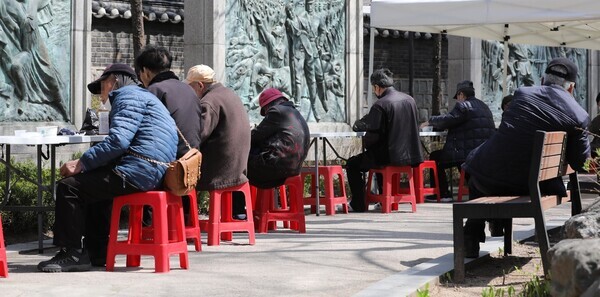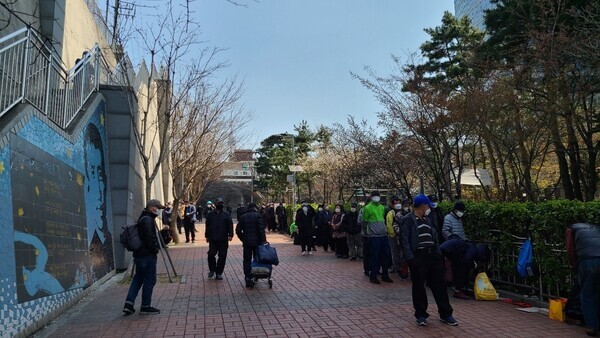hankyoreh
Links to other country sites 다른 나라 사이트 링크
“Everything is expensive”: S. Korea’s disadvantaged hit hard by soaring food prices

“Everything is expensive these days, so there are times when I just tide myself over with a beverage in the mornings. What am I supposed to do when prices go up? People like us have no choice but to wait and watch…”
On Wednesday afternoon, hundreds of older and unhoused Koreans were lined up outside of a soup kitchen near Seoul Station for food distributed by a local church.
While waiting to get his share, an individual surnamed Cho (77) lamented the rising price of food in recent days.
“I used to go to a restaurant once a month, but nowadays I can’t do that anymore. I mostly eat at the soup kitchen,” Cho said.
Another individual standing in the same line surnamed Kim (69) had similar concerns. “Nowadays due to the rising food prices I have a hard time buying groceries. Although I’m not in the best of health, I came here to at least get some snacks,” Kim said.
By 12:30 pm, volunteers ran out of around 250 lunch bags containing items like bananas, kimbap, ramen, and beverages after only 10 minutes of handing them out.
Consumer prices in South Korea were up 4.1% last month compared to the same time last year, marking the biggest increase in 10 years and 3 months. Soaring prices have Koreans worried. In particular, vulnerable populations are saying that the rising prices of processed foods (6.4%) and eating out (6.6%) is making it even more difficult for them to make ends meet.
The same day, a food bank in Seoul was bustling with visitors looking for food. A Seoul resident surnamed Hwang (65), who receives government financial assistance, told the Hankyoreh: “Of the stipend, I end up with only about 400,000 won I can actually use per month, but prices started to rise last year, and then skyrocketed this year, so I can't even buy anything when I go to the market.”
“Since scrap beef bones are cheap, I get some of those and make myself something to eat. But I can’t even dream of buying produce,” Hwang added.
Another individual at the food bank, surnamed Kim (65), shared a similar story. “My pension of 480,000 won a month is not enough to even buy spinach since the prices have risen so much. Even today, all I had for lunch was a glass of milk,” Kim said.

Organizations that provide food to the vulnerable also feel burdened by the increased cost of ingredients. Koh Young-bae, director of the Wongaksa soup kitchen near Tapgol Park said, “Grocery costs increased by 11% from 18 million won to 20 million won per month,” adding that “gas and electricity have also gone up while [financial] support has gone down due to the COVID-19 situation and rising prices.”
Park Jong-beom, head of outreach at Dail Community, which runs a free lunch program in the vicinity of Cheongnyangni Station, said, “The cost of distributing meals has gone up by more than 1,000 won from the original 3,500 won [per meal],” adding that the accumulating costs have been a burden.
An official working at a community center for children in Gyeonggi Province also shared their concerns about rising food prices.
“Since the prices of processed foods, vegetables, fruits, and rice have all gone up, I am taken aback every morning when I go to the market to get groceries,” the official said. “In order to stay within the limited budget, the quality of meals for children will inevitably decrease, such as by reducing the number of fruits or replacing domestic products with imported ones.”
Restaurants that are frequented by students and vulnerable groups have also had to raise prices.
“Recently we raised the price of each meal by 500 won while raising the price of ‘buy 10, get one free’ coupons by 300 won per meal,” said a restaurant proprietor surnamed Yoo (62), who has been running a diner catered to students in Seoul’s Sillim neighborhood for six years. “After enduring the [continuous] rise in prices, we had to raise [our own] prices too, but this year the prices have gone up more and we will run a deficit.”
The price of meals at university cafeterias has also gone up. A 25-year-old student enrolled at Seoul National University surnamed Lee said that they usually get lunch at school or nearby restaurants, but things have become more difficult now due to the higher prices. “Prices at the university dining hall have gone up from 4,000 won to 6,000 won,” Lee said, adding, “Now even the dining hall food we fell back on has us questioning where to get our meals.”
By Kim Yoon-ju, staff reporter; Park Ji-young, staff reporter; Ko Byung-chan, staff reporter
Please direct questions or comments to [english@hani.co.kr]

Editorial・opinion
![[Editorial] Intensifying US-China rivalry means Seoul must address uncertainty with Beijing sooner than later [Editorial] Intensifying US-China rivalry means Seoul must address uncertainty with Beijing sooner than later](https://flexible.img.hani.co.kr/flexible/normal/500/300/imgdb/original/2024/0517/8117159322045222.jpg) [Editorial] Intensifying US-China rivalry means Seoul must address uncertainty with Beijing sooner than later
[Editorial] Intensifying US-China rivalry means Seoul must address uncertainty with Beijing sooner than later![[Column] When ‘fairness’ means hate and violence [Column] When ‘fairness’ means hate and violence](https://flexible.img.hani.co.kr/flexible/normal/500/300/imgdb/original/2024/0516/7417158465908824.jpg) [Column] When ‘fairness’ means hate and violence
[Column] When ‘fairness’ means hate and violence- [Editorial] Yoon must stop abusing authority to shield himself from investigation
- [Column] US troop withdrawal from Korea could be the Acheson Line all over
- [Column] How to win back readers who’ve turned to YouTube for news
- [Column] Welcome to the president’s pity party
- [Editorial] Korea must respond firmly to Japan’s attempt to usurp Line
- [Editorial] Transfers of prosecutors investigating Korea’s first lady send chilling message
- [Column] Will Seoul’s ties with Moscow really recover on their own?
- [Column] Samsung’s ‘lost decade’ and Lee Jae-yong’s mismatched chopsticks
Most viewed articles
- 1[Editorial] Transfers of prosecutors investigating Korea’s first lady send chilling message
- 2[Exclusive] Unearthed memo suggests Gwangju Uprising missing may have been cremated
- 3[Column] US troop withdrawal from Korea could be the Acheson Line all over
- 4S. Korea “monitoring developments” after report of secret Chinese police station in Seoul
- 5‘Shot, stabbed, piled on a truck’: Mystery of missing dead at Gwangju Prison
- 6US has always pulled troops from Korea unilaterally — is Yoon prepared for it to happen again?
- 7Could Korea’s Naver lose control of Line to Japan?
- 8[Editorial] Intensifying US-China rivalry means Seoul must address uncertainty with Beijing sooner t
- 9[Column] When ‘fairness’ means hate and violence
- 10Xi, Putin ‘oppose acts of military intimidation’ against N. Korea by US in joint statement